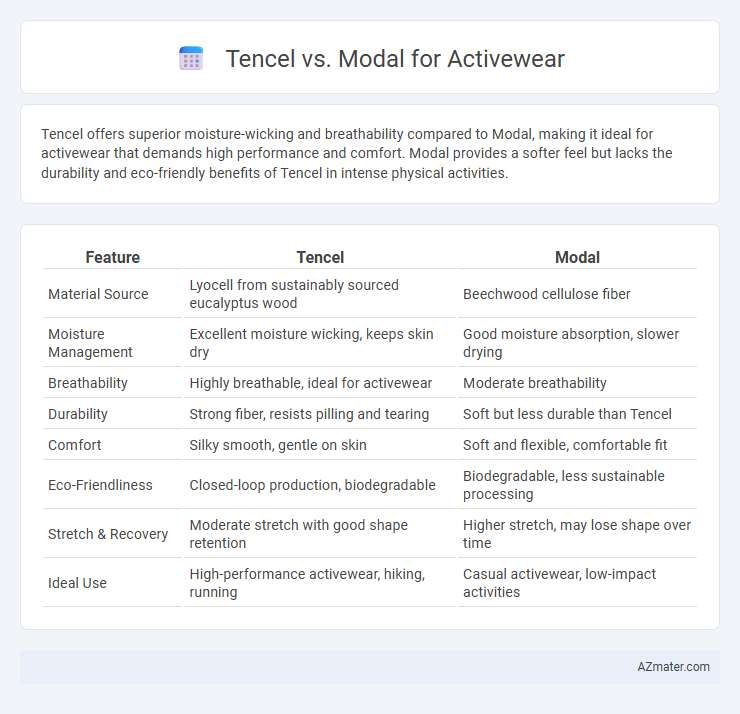Tencel offers superior moisture-wicking and breathability compared to Modal, making it ideal for activewear that demands high performance and comfort. Modal provides a softer feel but lacks the durability and eco-friendly benefits of Tencel in intense physical activities.
Table of Comparison
| Feature | Tencel | Modal |
|---|---|---|
| Material Source | Lyocell from sustainably sourced eucalyptus wood | Beechwood cellulose fiber |
| Moisture Management | Excellent moisture wicking, keeps skin dry | Good moisture absorption, slower drying |
| Breathability | Highly breathable, ideal for activewear | Moderate breathability |
| Durability | Strong fiber, resists pilling and tearing | Soft but less durable than Tencel |
| Comfort | Silky smooth, gentle on skin | Soft and flexible, comfortable fit |
| Eco-Friendliness | Closed-loop production, biodegradable | Biodegradable, less sustainable processing |
| Stretch & Recovery | Moderate stretch with good shape retention | Higher stretch, may lose shape over time |
| Ideal Use | High-performance activewear, hiking, running | Casual activewear, low-impact activities |
Introduction to Tencel and Modal Fabrics
Tencel and Modal are both sustainable fibers derived from cellulose, primarily sourced from eucalyptus and beech trees, making them eco-friendly choices for activewear. Tencel features a smooth, breathable surface with moisture-wicking properties, ideal for high-performance athletic wear. Modal offers exceptional softness, flexibility, and durability, enhancing comfort and movement in activewear garments.
What is Tencel? Key Features for Activewear
Tencel, a brand name for lyocell fibers derived from sustainably sourced eucalyptus wood pulp, offers exceptional moisture-wicking and breathability, making it ideal for activewear. Its natural antibacterial properties reduce odor, enhancing comfort during intense workouts. Tencel's smooth, soft texture combined with high tensile strength ensures durability and a luxurious feel against the skin in performance apparel.
What is Modal? Key Features for Activewear
Modal, a semi-synthetic fabric derived from beech tree pulp, is prized for its exceptional softness, breathability, and moisture-wicking properties, making it ideal for activewear. Its high elasticity and durability provide comfort and shape retention during intense physical activities. Modal's natural resistance to shrinkage and fading ensures longevity, while its eco-friendly production contributes to sustainable activewear solutions.
Moisture Management: Tencel vs Modal
Tencel offers superior moisture management compared to Modal due to its highly absorbent fibers that wick sweat away efficiently, keeping activewear dry and comfortable. Modal fibers also provide good moisture absorption but tend to retain more moisture, which may lead to dampness during intense workouts. The advanced moisture-wicking properties of Tencel make it a preferred choice for activewear designed for high-performance and long-lasting freshness.
Breathability and Comfort Comparison
Tencel offers superior breathability due to its moisture-wicking properties, making it ideal for high-intensity activewear that requires efficient sweat management. Modal provides a soft, smooth touch with excellent comfort but tends to retain more moisture, which may reduce breathability during prolonged exercise. Both fibers are sustainable and breathable, but Tencel's enhanced airflow and quick-drying features give it an edge for performance-focused activewear.
Durability and Performance in Workouts
Tencel offers superior moisture-wicking and temperature regulation, enhancing comfort during intense workouts, while its lyocell fibers provide excellent durability against wear and tear. Modal, made from beech tree pulp, is softer and more breathable but tends to be less durable with frequent washing and heavy activity. For high-performance activewear, Tencel's strength and resilience make it a preferred choice over Modal in maintaining fabric integrity and consistent workout performance.
Eco-Friendliness and Sustainability
Tencel, derived from sustainably sourced eucalyptus wood, boasts a closed-loop production process that recycles water and solvents, making it highly eco-friendly compared to Modal, which uses beech trees and typically involves more water and chemical consumption. Both fibers offer biodegradability, but Tencel's lower environmental footprint in manufacturing and faster biodegradation rate position it as the more sustainable choice for activewear. Brands prioritizing sustainability often select Tencel for its balance of performance, softness, and environmental responsibility.
Care and Maintenance Differences
Tencel activewear requires gentle washing in cold water to maintain its moisture-wicking properties and natural softness, while Modal fabrics benefit from low-temperature washes and should be air-dried to preserve their smooth texture and resistance to shrinking. Both fibers avoid high heat and harsh detergents, but Modal's inherent durability allows for slightly more lenient care without compromising longevity. Proper care of Tencel and Modal ensures sustained breathability and flexibility, crucial for high-performance activewear.
Price Comparison: Tencel vs Modal Activewear
Tencel activewear typically commands a higher price point than Modal due to its eco-friendly production process and superior moisture-wicking properties. Modal offers a more budget-friendly alternative while maintaining softness and breathability, making it popular for affordable activewear options. Price sensitivity among consumers often drives the choice between Tencel's premium durability and Modal's cost-effective comfort in performance apparel.
Which Fabric is Better for Activewear?
Tencel and Modal are both sustainable fibers derived from wood pulp, but Tencel offers superior moisture-wicking and breathability, making it better suited for activewear. Modal provides a softer feel and excellent stretch but lacks the same level of durability and odor resistance as Tencel. For high-performance activewear, Tencel's enhanced moisture management and antimicrobial properties make it the preferred choice.

Infographic: Tencel vs Modal for Activewear
 azmater.com
azmater.com